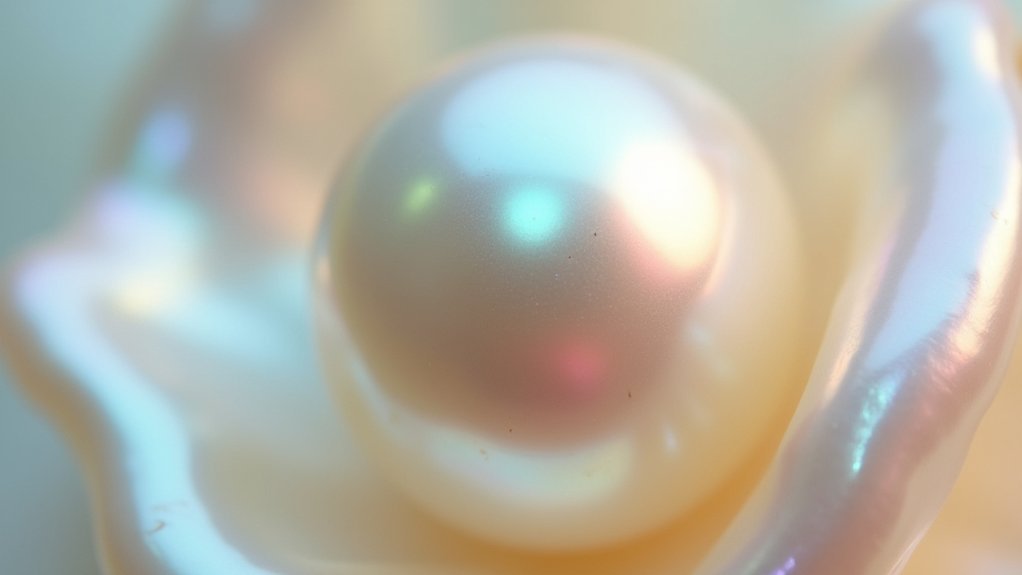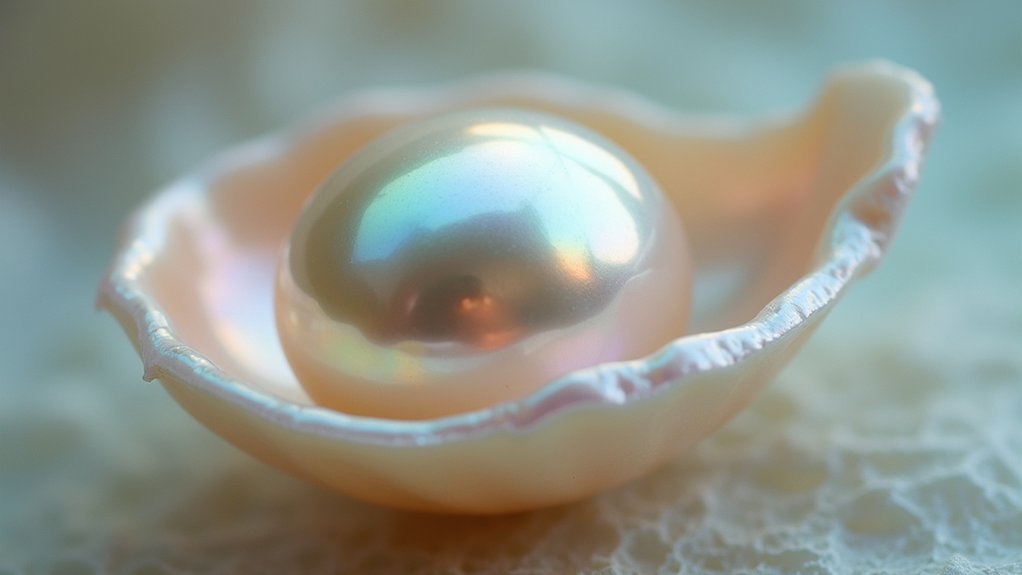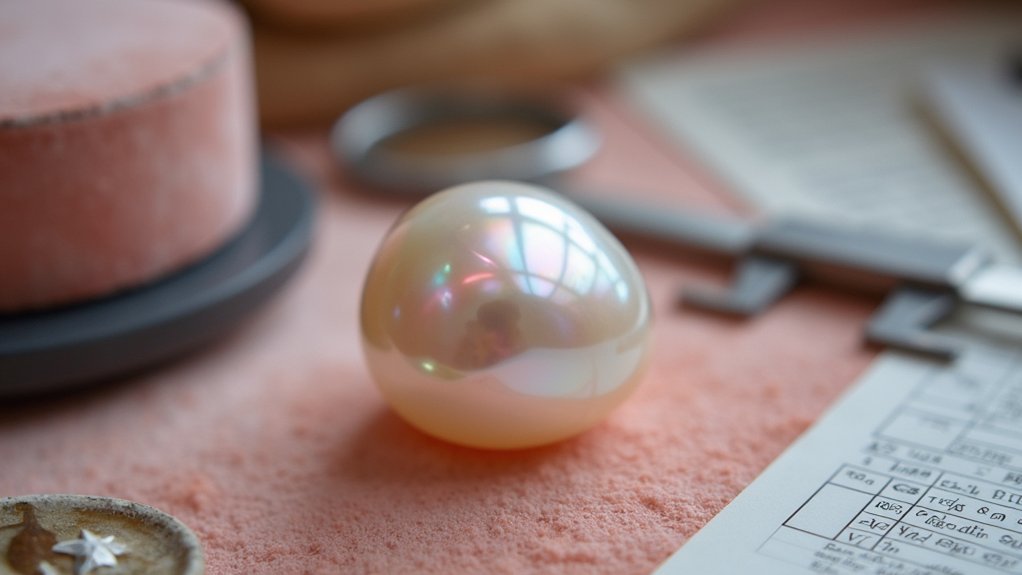Pearl luster assessment is your most essential skill for pearl valuation. As the primary determinant of market value, understanding luster directly affects your pricing strategy and profit margins. You’ll establish credibility when you can confidently explain why one pearl commands premium prices while another doesn’t. With proper lighting techniques and consistent evaluation methods, you’ll make better purchasing decisions and effectively communicate quality differences to customers. Master this assessment to transform casual shoppers into confident buyers.
The Scientific Basis of Pearl Luster Evaluation

While many jewelers rely on intuition when evaluating pearls, understanding the scientific principles behind luster evaluation provides a more accurate and consistent approach.
Pearl luster fundamentally depends on how light interacts with the nacre, creating those sharp, bright reflections you’ll immediately recognize in high-quality specimens.
The dance between light and nacre defines a pearl’s true value—those razor-sharp reflections speak volumes about quality.
You’ll want to assess both the quality and quantity of light reflected from the pearl’s surface. The GIA’s standardized grading system—ranging from Excellent to Poor—gives you objective criteria to follow.
Remember that nacre thickness directly influences reflection properties; thicker, higher-quality nacre layers produce superior luster.
Don’t overlook surface quality in your assessment. Smooth surfaces reflect light more effectively than blemished ones.
Mastering these scientific principles helps you identify truly valuable pearls and provide more informed guidance to your clients.
Pearl Luster Grading Scales: GIA Standards and Beyond
Although many jewelers develop an intuitive sense for pearl quality, the GIA’s standardized luster grading scale provides essential structure to your assessments. This scale ranges from Excellent to Poor, with Excellent luster displaying bright, sharp reflections on the surface that instantly signal quality pearls.
When evaluating pearls, you’ll notice that Very Good luster shows bright reflections lacking complete sharpness, while Poor luster appears dim and hazy. Your luster assessment should consider both quality and quantity of light reflected, as high luster dramatically increases pearl value.
Remember that nacre thickness and surface condition directly influence luster quality. The pearl’s round shape functions as a convex mirror, enhancing reflections.
Mastering the GIA grading scale gives you credibility with customers who notice luster first when considering purchases.
Tools and Lighting for Accurate Luster Assessment

You’ll need specific lighting equipment including daylight-balanced LEDs or light boxes to properly evaluate a pearl’s reflective qualities without distortion.
Use magnification tools such as a 10x jeweler’s loupe to examine surface details that affect luster perception, particularly when evaluating minor imperfections.
Having comparison pearls of known quality grades enables you to place unfamiliar specimens within the appropriate luster range through side-by-side visual analysis.
Lighting Equipment Options
Three essential lighting tools stand at the forefront of professional pearl luster assessment.
First, daylight-balanced LED light sources (5000K-6500K) provide consistent illumination that closely mimics natural light, allowing you to evaluate surface quality with precision. These lights reveal subtle variations in luster that might otherwise go unnoticed.
Second, light tents or softboxes diffuse illumination evenly across the pearl’s surface, eliminating harsh shadows that can obscure important details. This even distribution highlights the pearl’s true reflective properties.
Finally, portable light sources with adjustable intensity give you flexibility when working in different environments.
Pair these lighting equipment options with a magnifying loupe to detect minor blemishes that affect luster perception. Your investment in proper lighting tools will dramatically improve assessment accuracy and your professional credibility as a jeweler.
Magnification and Comparison
Magnification tools complement your lighting setup by revealing pearl luster details invisible to the naked eye. Quality loupes or microscopes allow you to assess subtle reflections on the pearl’s surface with precision, helping you evaluate luster quality more accurately than visual inspection alone.
When you compare pearls, always place them side-by-side under identical lighting conditions. This direct comparison highlights luster differences between various types and grades.
Consider establishing a collection of calibrated reference pearls with known luster grades to create a consistent evaluation baseline for your inventory.
Remember that diffuse natural light provides the ideal environment for luster assessment, minimizing glare that can interfere with your evaluation.
Combine this with a standardized lighting setup featuring both direct and indirect light sources to guarantee your magnification tools capture true luster characteristics.
Common Challenges in Differentiating Luster Qualities
You’ll often find yourself struggling to distinguish between subtle gradations of pearl luster, especially when comparing specimens with only minor differences in reflective quality.
The ambiguities created by varying light conditions can further complicate your assessment, as the same pearl might display different luster characteristics under natural versus controlled lighting.
Training your eye to recognize these nuanced distinctions requires extensive practice with verified reference samples and consistent evaluation techniques that account for how light interacts with the pearl’s surface.
Subtle Distinction Barriers
Despite years of training, even experienced jewelers encounter significant challenges when differentiating between subtle luster qualities in pearls.
The subjective nature of evaluating how light interacts with the Pearl Surface complicates consistency in the GIA grading system application.
When you’re trying to assess the quality of luster, you’ll face several barriers:
- Inconsistent lighting conditions can dramatically alter how nacre thickness appears to reflect light.
- The subtle difference between “Excellent” and “Very Good” grades often blurs under varied environmental factors.
- Pearl Quality variations among different types (Akoya vs. Tahitian) require specialized knowledge for fair comparison.
- Your personal preferences may unconsciously influence judgments, particularly when determining which pearls command higher value.
Understanding these distinction barriers helps you develop more accurate assessment skills despite the inherent complexities.
Light Reflection Ambiguities
When examining pearl luster under diverse lighting conditions, you’re likely to encounter significant reflection ambiguities that challenge even seasoned appraisers.
The subjective nature of light reflection creates inconsistencies in assessment, as your position relative to the pearl dramatically alters what you’ll observe.
You’ll notice that pearls with very good luster can appear nearly identical to those with excellent luster depending on the angle of illumination.
Surface imperfections further complicate your evaluation by diffusing light in unpredictable ways.
As a jeweler, you must recognize that variations in nacre thickness produce subtle luster qualities that aren’t immediately distinguishable.
This requires developing a trained eye that can detect nuanced differences between luster grades while acknowledging the inherent ambiguity in how light interacts with these organic gems.
Pearl Luster’s Impact on Pricing and Market Value

Among all pearl quality factors, luster stands as the most influential determinant of a pearl’s market value.
When you’re evaluating pearl luster, understand that the Gemological Institute of America’s grading system directly correlates to pricing—pearls with “Excellent” luster command premium prices in the market.
Your customers are instinctively drawn to high-luster pearls because:
The magnetic allure of brilliance captivates buyers, making a pearl’s luminous quality the ultimate value determinant in fine jewelry selection.
- Sharp, bright reflections signal superior quality pearl craftsmanship
- Metallic sheen found in Akoya pearls creates immediate visual appeal
- High-luster pearls often outvalue larger but duller alternatives
- Market demand consistently favors pearls with mirror-like reflections
You’ll notice this psychological attraction translates directly to pricing strategies, where a pearl’s brilliance often becomes the deciding factor in a customer’s willingness to pay more.
Communicating Luster Quality to Customers Effectively
How effectively you communicate pearl luster can transform a casual shopper into a confident buyer. Make it clear that luster outweighs even surface flaws in determining pearl value.
Use the GIA grading scale—ranging from Excellent with sharp reflections to Poor with hazy appearances—to provide objective quality assessments.
Show customers how to evaluate light reflections on pearl surfaces, making luster assessment accessible. Explain that nacre thickness directly influences shine, helping them understand why premium pearls command higher prices.
When showcasing Hanadama Akoya pearls, highlight their exceptional brightness as the gold standard of luster quality.
Frequently Asked Questions
How Do You Evaluate Quality of Pearls?
You’ll evaluate pearls by examining their luster, size, shape, surface quality, color, and nacre thickness. Look for bright, clear reflections, minimal blemishes, and consistent coloration to determine their overall value and quality.
What Does High Luster Pearls Mean?
High luster pearls have bright, sharp reflections that resemble a mirror-like sheen. You’ll notice they’re more vibrant and enchanting than duller pearls, with rich iridescence resulting from thick, quality nacre layers.
What Are the GIA 7 Pearl Value Factors?
The GIA’s 7 Pearl Value Factors you’ll need to know are size, shape, color, luster, surface quality, nacre thickness, and matching. These elements work together to determine a pearl’s overall value and quality.
What Is the Difference Between AAA and AAAA Pearl Quality?
AAAA pearls offer exceptional luster with mirror-like reflections, while AAA pearls have very good but less sharp shine. You’ll notice AAAA pearls have fewer surface imperfections and command higher prices for their superior quality.
In Summary
You’ll find mastering pearl luster assessment gives you a competitive edge in the jewelry industry. It’s not just about scientific knowledge but about building trust with customers through consistent, accurate evaluations. By using proper lighting, understanding grading standards, and clearly communicating luster qualities, you’re positioning yourself as an expert while maximizing your inventory’s value. Ultimately, your expertise in luster assessment directly impacts your bottom line.





Leave a Reply